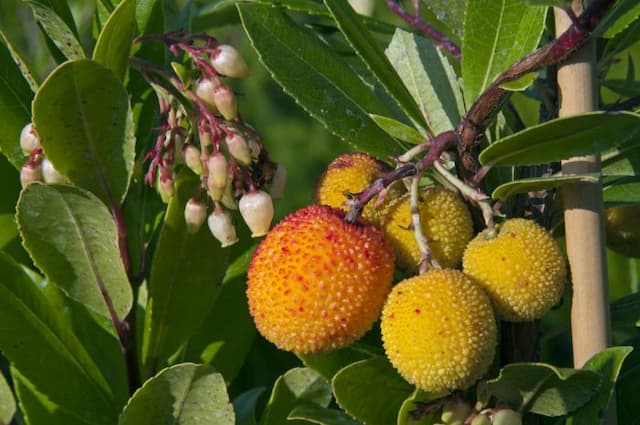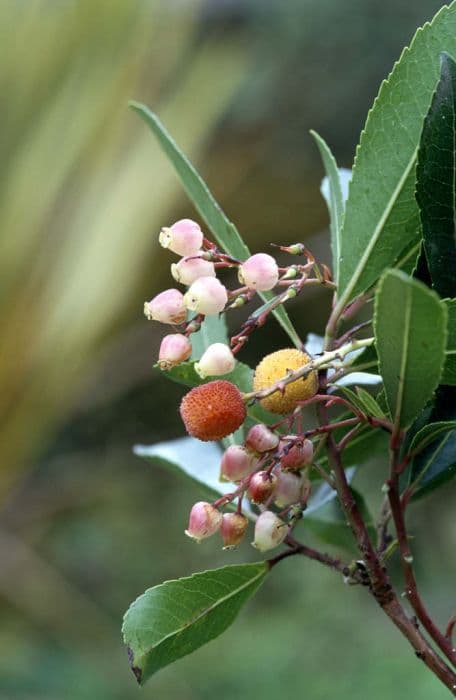Rhododendron Rhododendron 'Markeeta's Prize'

ABOUT
Rhododendron 'Markeeta's Prize' is noted for its striking appearance, which makes it a popular choice among garden enthusiasts. This rhododendron variety has lush, evergreen foliage that provides a year-round backdrop of deep green leaves. The leaves are typically oval-shaped with a smooth texture and a glossy finish, which accentuates their rich color. The plant is best known for its vibrant flowers, which bloom in clusters known as trusses. Each truss consists of numerous trumpet-shaped flowers, often with frilly edges that add to their ornamental appeal. The flowers of 'Markeeta's Prize' are a remarkable shade of deep pink or reddish-purple, which can vary in intensity, and they often display a spotted pattern within the throat of the bloom. These blossoms are particularly large and showy, making them a prominent feature in any garden when the plant is in bloom. The contrast between the vivid flowers and the shiny green leaves is stunning and can bring a lively burst of color to a garden landscape. Overall, Rhododendron 'Markeeta's Prize' boasts a magnificent floral display that is both elegant and eye-catching, coupled with its evergreen foliage, which provides consistent visual interest throughout the seasons.
About this plant
 Names
NamesSynonyms
Rosebay, Azalea
Common names
Rhododendron 'Markeeta's Prize'
 Toxicity
ToxicityTo humans
Rhododendrons, including the variety 'Markeeta's Prize', contain toxic compounds that can be harmful when ingested. All parts of the plant, including leaves, flowers, and nectar, contain grayanotoxins which can affect the sodium channels in cell membranes. If ingested in large enough quantities, these toxins can cause symptoms like burning sensation in the mouth, excessive drooling, vomiting, diarrhea, low blood pressure, headaches, muscle weakness, and blurred vision. In severe cases, ingestion can lead to cardiac problems, coma, and even death. It is advised to seek medical attention immediately if any part of the plant is ingested.
To pets
Rhododendrons, including the variety 'Markeeta's Prize', are toxic to pets like dogs, cats, and horses. The entire plant contains grayanotoxins, which can cause vomiting, diarrhea, hypersalivation, weakness, coma, hypotension, central nervous system depression, cardiovascular collapse, and potentially death if ingested. These toxins affect the body's ability to maintain proper cellular sodium and potassium balance, which disrupts normal function. It is critical to prevent pets from accessing any part of the plant and to seek veterinary care promptly if ingestion is suspected.
 Characteristics
CharacteristicsLife cycle
Perennials
Foliage type
Evergreen
Color of leaves
Green
Flower color
Pink
Height
6 feet (1.83 meters)
Spread
6 feet (1.83 meters)
Plant type
Shrub
Hardiness zones
5
Native area
Asia
Benefits
 General Benefits
General Benefits- Vibrant Blooms: Rhododendrons, including 'Markeeta's Prize', are known for their spectacular flowers that add a splash of color to gardens during their blooming season.
- Attracts Pollinators: The bright and showy flowers can attract bees, butterflies, and other beneficial pollinators, supporting local ecosystems.
- Evergreen Foliage: Being an evergreen shrub, it provides year-round interest with its glossy leaves that maintain their color and texture even in winter.
- Landscape Versatility: This plant can be used in various landscape designs, from accent plants to hedges or mass plantings.
- Shade Tolerance: Rhododendrons are well-suited for shaded areas where other plants may struggle to grow, making them ideal for woodland gardens.
- Erosion Control: Their root systems help stabilize soil on slopes, reducing the risk of erosion.
- Durable: They are often long-lived shrubs that can withstand varying climatic conditions once established.
- Low Maintenance: Once established, Rhododendrons, including 'Markeeta's Prize', generally require minimal maintenance apart from occasional pruning and watering.
 Medical Properties
Medical PropertiesThis plant is not used for medical purposes.
 Air-purifying Qualities
Air-purifying QualitiesThis plant is not specifically known for air purifying qualities.
 Other Uses
Other Uses- Photography: Rhododendron blossoms are popular subjects for photographers looking for natural beauty and intricate detail.
- Floral Arrangements: The captivating flowers of Rhododendrons can be used in creating stunning, long-lasting floral arrangements.
- Garden Design: With their striking flowers and evergreen leaves, Rhododendrons can be used to create focal points in garden designs.
- Wedding Decor: Rhododendrons can add a splash of natural elegance to wedding venue decorations, especially for springtime ceremonies.
- Arts and Crafts: The flowers and leaves of Rhododendrons can be used in pressed flower art or to create natural dyes for fabrics.
- Culinary Garnish: Though not all parts are edible, some Rhododendron petals may be used to garnish dishes, but with caution due to potential toxicity.
- Petal Confetti: Biodegradable and natural, Rhododendron petals can be used as eco-friendly confetti in celebrations.
- Habitat Support: Rhododendrons can provide shelter and food for various bird species and beneficial insects in the garden.
- Bonsai: With careful pruning and care, Rhododendrons can be grown as bonsai trees, bringing beauty in miniature form.
- Religious Ceremonies: In certain cultures, Rhododendron flowers are used in offerings and ceremonies due to their significant beauty.
Interesting Facts
 Feng Shui
Feng ShuiThe Rhododendron is not used in Feng Shui practice.
 Zodiac Sign Compitability
Zodiac Sign CompitabilityThe Rhododendron is not used in astrology practice.
 Plant Symbolism
Plant Symbolism- Warning: Rhododendrons often symbolize caution due to their toxicity to both humans and animals if ingested.
- Beware: In the Victorian language of flowers, Rhododendrons can communicate a sense of warning or danger, reminding one to be careful.
- Abundance: With their lush, full blooms, Rhododendrons can represent abundance or wealth.
- Beauty: The magnificent, showy flowers of the Rhododendron make it a symbol of beauty and elegance.
- Temperance: The Rhododendron's evergreen leaves symbolize moderation and restraint in life's pleasures.
 Water
WaterRhododendrons, including 'Markeeta's Prize,' require consistent moisture, so they should be watered deeply when the top inch of soil feels dry to the touch. It's crucial to water thoroughly at the base of the plant, avoiding wetting the leaves directly to prevent disease. Typically, watering once a week with about 1 inch of water—equivalent to roughly 0.6 gallons per square yard—should be sufficient, but this can vary with climate and soil conditions. During dry spells or hot weather, more frequent watering may be necessary, while in cooler or rainy periods, less water might be needed. Ensure that the plant is in well-draining soil to prevent water logging, which can lead to root rot.
 Light
LightThe Rhododendron 'Markeeta's Prize' thrives best in dappled shade or partial sunlight, where it's protected from the harsh afternoon sun. An optimal spot would be under the canopy of tall deciduous trees that provide filtered light. Avoid deep shade locations, as rhododendrons require some light for healthy growth and flowering, but equally avoid full sun which can scorch their leaves.
 Temperature
TemperatureRhododendrons like 'Markeeta's Prize' prefer moderate climates and can generally withstand temperatures as low as 20 degrees Fahrenheit. They perform best in temperatures ranging between 50 and 70 degrees Fahrenheit. To protect the evergreen foliage, avoid exposure to harsh winter winds and temperatures below 20 degrees Fahrenheit for prolonged periods.
 Pruning
PruningPrune Rhododendron 'Markeeta's Prize' shortly after flowering to maintain plant shape and encourage bushier growth. This timing allows the plant to set buds for next year's blooms. Remove any dead or diseased branches, as well as any spindly growth, to improve air circulation and the overall health of the plant. Pruning is typically done once a year, but light trimming can be done as needed.
 Cleaning
CleaningAs needed
 Soil
SoilRhododendrons, including 'Markeeta's Prize', thrive in well-drained, acidic soil with a pH between 4.5 and 6.0. A mix of 50% pine bark, 40% peat moss, and 10% perlite creates an ideal growing medium that retains moisture while allowing excess water to drain, preventing root rot.
 Repotting
RepottingRhododendrons like 'Markeeta's Prize' generally require repotting every 2 to 3 years, or when they become root-bound. Early spring or fall, after blooming, is the best time to repot these plants.
 Humidity & Misting
Humidity & Misting'Markeeta's Prize' Rhododendron prefers high humidity but is tolerant of a range typical in many homes. Aim for a humidity level between 40-60% for optimal growth.
 Suitable locations
Suitable locationsIndoor
Place in bright, indirect light with acidic soil; keep evenly moist.
Outdoor
Plant in partial shade, moist acidic soil, shelter from harsh winds.
Hardiness zone
5-8 USDA
 Life cycle
Life cycleThe Rhododendron 'Markeeta's Prize', commonly known as Rhododendron, begins its life as a seed, often starting to germinate in the cool and moist conditions of spring. Upon germination, the seedling establishes roots and shoots, and if conditions are favorable, it develops into a young plant with characteristic evergreen leaves. As the plant matures, it undergoes vegetative growth, producing sturdy branches and a robust root system. Upon reaching maturity, which can take several years, it blooms in the spring with showy flowers that range in color, attracting pollinators such as bees and butterflies. After pollination, flowers form seed capsules that eventually release seeds, continuing the reproductive cycle. During its life, the Rhododendron may experience periods of dormancy, particularly in colder climates during the winter months, only to resume vigorous growth with the return of warmer weather.
 Propogation
PropogationPropogation time
Spring-Early Summer
Rhododendron 'Markeeta's Prize', a popular cultivar of Rhododendrons, is commonly propagated through semi-hardwood cuttings. The best time to take these cuttings is during the late summer or early fall after new growth has partially matured. This method involves cutting a 4 to 6 inch length from a healthy, non-flowering branch. The bottom leaves are removed, and the cut end may be dipped in rooting hormone to encourage root growth. The cutting is then planted in a mixture of peat and perlite or a well-draining potting mix. The environment should be kept humid, which is often achieved by covering the cutting with a plastic bag or placing it in a propagation case. This creates a greenhouse effect, maintaining moisture while the cutting develops roots, a process that typically takes several weeks.









